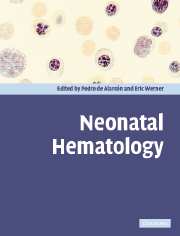Book contents
- Frontmatter
- Contents
- List of contributors
- Foreword
- Preface
- 1 Neonatal hematology: a historical overview
- 2 Disorders of the fetomaternal unit
- 3 Erythropoiesis, red cells, and the approach to anemia
- 4 Anemia of prematurity and indications for erythropoietin therapy
- 5 Hypoplastic anemia
- 6 Hemolytic disease of the fetus and newborn
- 7 Neonatal hemolysis
- 8 Neonatal screening for hemoglobinopathies
- 9 Polycythemia and hyperviscosity in the newborn
- 10 Newborn platelet disorders
- 11 Neutrophil function and disorders of neutrophils in the newborn
- 12 Immunodeficiency diseases of the neonate
- 13 Hemostatic abnormalities
- 14 Transfusion practices
- 15 Umbilical-cord stem-cell transplantation
- 16 Neonatal oncology
- 17 Normal values and laboratory methods
- Index
- References
11 - Neutrophil function and disorders of neutrophils in the newborn
Published online by Cambridge University Press: 10 August 2009
- Frontmatter
- Contents
- List of contributors
- Foreword
- Preface
- 1 Neonatal hematology: a historical overview
- 2 Disorders of the fetomaternal unit
- 3 Erythropoiesis, red cells, and the approach to anemia
- 4 Anemia of prematurity and indications for erythropoietin therapy
- 5 Hypoplastic anemia
- 6 Hemolytic disease of the fetus and newborn
- 7 Neonatal hemolysis
- 8 Neonatal screening for hemoglobinopathies
- 9 Polycythemia and hyperviscosity in the newborn
- 10 Newborn platelet disorders
- 11 Neutrophil function and disorders of neutrophils in the newborn
- 12 Immunodeficiency diseases of the neonate
- 13 Hemostatic abnormalities
- 14 Transfusion practices
- 15 Umbilical-cord stem-cell transplantation
- 16 Neonatal oncology
- 17 Normal values and laboratory methods
- Index
- References
Summary
Introduction
The phagocytes comprise a small group of hematopoietically derived cells that play diverse roles in human host defense. The name, coined by Elie Metchnikoff over a century ago [1], refers to one of their most prominent specializations – the ability to ingest particulate targets. However, Metchnikoff's “microphages” and “macrophages” do much more than simply ingest foreign materials. They are now appreciated to perform multiple roles in inflammation and host defense, in both the innate and adaptive arms of immunity. This chapter will address phagocytic cells in their host-defense roles as they relate to innate immunity, using the polymorphonuclear leukocyte (PMN) and its functions in the human neonate as the major focus of discussion.
Neonatal phagocyte production
Hematopoiesis in the fetus is initiated in the yolk sac, with the formation of “blood islands” from primitive blood progenitor cells. By the second month of gestation, the fetal liver becomes the major site of blood-cell production, which then extends to include the spleen by five months' gestation. At about the same time, the earliest components of marrow-based blood production appear and continue to become more prominent over the subsequent months leading up to term, while splenic and hepatic hematopoiesis diminish. During this time, pluripotent hematopoietic stem cells are present in the circulation [2], presumably in transit from the hepatic and splenic hematopoiesis sites to the marrow to populate the latter for subsequent blood-cell production during extrauterine life.
- Type
- Chapter
- Information
- Neonatal Hematology , pp. 254 - 279Publisher: Cambridge University PressPrint publication year: 2005



